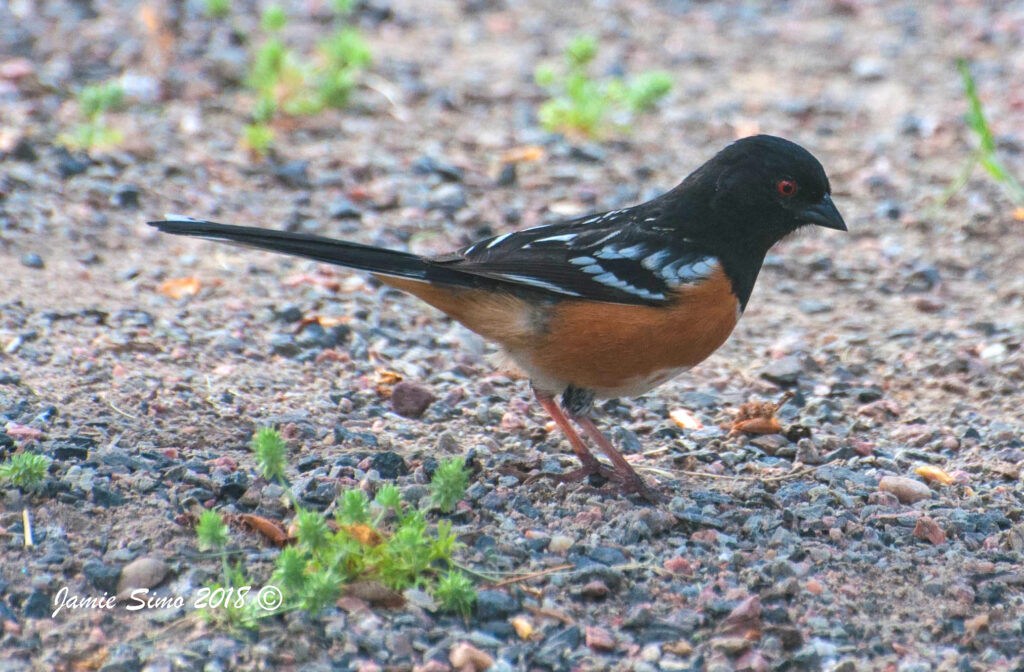After a very cold and windy Thursday scouting out Waneka Lake and Greenlee Preserve for February’s bird walk, it was a relief for Saturday’s sun and calm winds. While the lake was mostly frozen, there were a couple circles of open water and we were able to get decent looks at Green-winged Teal and a lone, male Common Merganser. From a distance, the creamy patch near the Green-winged Teal’s tail is a great field mark to look for. Males in breeding plumage also have a white, vertical stripe on their “shoulder,” which is visible from the side.

Although there wasn’t much open water for geese, we saw many Canada and Cackling Geese flying over. In one group there was even a Snow Goose. Snow Geese will often intermix with flocks of Canada Geese, so keep an eye out for anything out of the ordinary!
We had better luck with songbirds than waterfowl. Before we had even left the parking lot, we were treated to a cacophony of European Starling chatter as they scouted out nesting cavities in the big trees between the parking lot and lake. Northern Flickers were also active pecking around on the ground possibly for their favorite food of ants. We even saw one female Northern Flicker with yellow wing and tail linings, a sign of a hybrid red-shafted x yellow-shafted flicker.
At the feeders near the shack we were treated to great views of Spotted Towhees and White-crowned Sparrows. Spotted Towhees are particularly striking with their black, orange, and white coloring. Towhees love tangles of brush and as ground feeders can be attracted to millet on a low platform or sprinkled on the ground.

Probably the highlight of the morning for me was the immature Red-tailed Hawk that posed in a tree not that far away from us then soared low directly over our heads. At the end of the walk she (female raptors are bigger than males and this was a fairly large bird) even landed on a power pole directly over our heads. Red-tailed Hawks are extremely variable, but even though immature Red-tails lack the red tail, you may still be able to distinguish them by their chocolate brown head, belly band (can be variable, but the belly band was thick and obvious on this bird), white scapular (shoulder) V, and, if soaring, their bulging secondary wing feathers and dark patagial marks.
All in all, it was a gorgeous day for birding and we saw 25 species. Not bad for mid-February! Happy birding!
Waneka Lake/Greenlee Preserve, Boulder, Colorado, US
25 species (+4 other taxa)
Snow Goose 1
Cackling Goose 4
Canada Goose 36
Cackling/Canada Goose 47
Mallard 5
Green-winged Teal 4
Common Merganser 1
Eurasian Collared-Dove 5
Ring-billed Gull 8
Red-tailed Hawk 2
Downy Woodpecker (Rocky Mts.) 2
Northern Flicker 4
Northern Flicker (Yellow-shafted) 1
Blue Jay 3
American Crow 2
Black-capped Chickadee 5
White-breasted Nuthatch (Interior West) 2
European Starling 16
Townsend’s Solitaire 1
American Robin 1
House Sparrow 6
House Finch 6
Dark-eyed Junco 1
Dark-eyed Junco (Slate-colored) 1
Dark-eyed Junco (Oregon) 1
White-crowned Sparrow 8
Song Sparrow 2
Spotted Towhee 6
Red-winged Blackbird 14


Comments
Write Comment